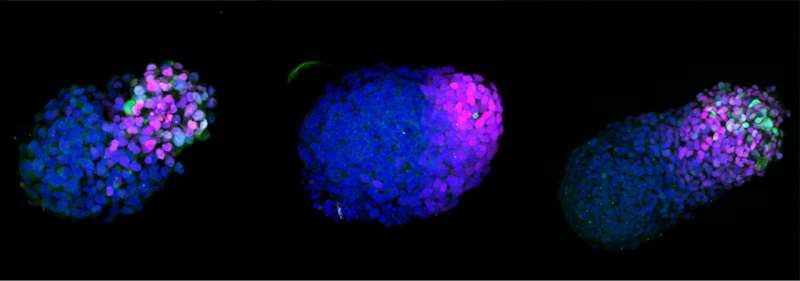This article has been reviewed according to Science X's editorial process and policies. Editors have highlighted the following attributes while ensuring the content's credibility:
fact-checked
trusted source
proofread
UK issues guidelines for use of stem cell-based embryo models in research

Stem cell-based embryo models (SCBEMs) are three-dimensional biological structures that mimic aspects of early human embryo development. They can be created in the lab from stem cells, and can provide new insights into critical stages of early human development that are normally inaccessible to researchers.
Embryo model work is expected to lead to new interventions for a range of conditions, including revolutionizing treatments for recurrent miscarriage, understanding developmental disorders and improving the success rate of IVF.
Although embryo models are not the same as human embryos, they mimic aspects of early human development—and this has raised ethical concerns.
The previous lack of a regulatory framework for the use of SCBEMs in research has left scientists and research organizations uncertain about the acceptable boundaries of their work, both legally and ethically, and unsupported in their decision-making. Signing up to the SCBEM Code of Practice will remove these obstacles.
The guidelines, released today, provide the first code of practice for the use of stem cell-based embryo models in the UK.
"The new Code of Practice provides processes for decision-making in research using stem cell-based embryo models so that scientists can proceed confidently, while maintaining public trust in this vital area of research," said Kathy Niakan, Chair of Cambridge Reproduction and Professor of Reproductive Physiology at the University of Cambridge, and member of the SCBEM Code of Practice Working Group.
"We are confident that the Code will enable the UK to continue to lead the world in research into early human development, while ensuring that this research is ethically robust," said Professor Roger Sturmey, Professor of Reproductive Medicine at Hull York Medical School and Chair of the SCBEM Code of Practice Working Group.
Key points of the Code
The new SCBEM Code of Practice sets out standards to make sure that research using SCBEMs is rigorous, upholds ethical principles and maximizes the potential benefits. Key to this will be a dedicated oversight committee that will review each proposed research project.
The Code recognizes that there must be a limit to how long embryo models can be grown in the lab. However, many different types of embryo model are being developed, representing distinct developmental stages and developing at different rates, making it impossible to impose a single fixed limit. Instead, researchers are asked to provide clear justification of the length of their experiments on a case-by-case basis.
The Code prohibits any human SCBEM from being transferred into the womb of a human or animal, or being allowed to develop into a viable organism in the lab.
"Embryo models have huge potential and we want to realize this, while also limiting the risks. The new Code of Practice will allow stem cell-based embryo models to be grown in the lab long enough to gain meaningful biological understanding, but the Code asks researchers to fully justify what they're doing in scientific and ethical terms," said Niakan.

How are embryo models useful to research?
Research using embryo models can improve knowledge of human development, including early pregnancy loss and pregnancy disorders, congenital defects and the precursor events that affect adult human health and disease.
The models could also be used for some investigations that are not permitted using human embryos. For example, there are currently significant limitations to clinical trials and the use of many medicines during pregnancy. Models of early development could be helpful to improve options for drug treatments during pregnancy in the future.
Stem cell-based embryo models open new research avenues that can complement—but not replace—the limited studies possible with actual human embryos. The SCBEM Code of Practice states that neither of these areas of research can or should replace the other for the foreseeable future.
How was the Code produced?
The SCBEM Code of Practice Working Group was made up of researchers and practitioners at institutions across the UK, including experts in science, law, ethics and regulation. In drawing up the Code, the team consulted widely with researchers, practitioners, and major funders and regulators of embryo model research, both within the UK and internationally.
The SCBEM Code of Practice Working Group included researchers and practitioners from the Babraham Institute, Biolawgy, Brighton and Sussex Medical School, the Centre of Medical Law and Ethics at King's College London, the Francis Crick Institute, Hull York Medical School, the Medical Research Council, Newcastle University, University College London, the University of Cambridge, the University of Edinburgh, the University of Exeter and the University of Manchester.
The work was also informed by a public dialogue, held earlier this year, to explore public attitudes towards research involving embryo models.
"Throughout the process of developing the Code of Practice, we've been keen to engage with as wide a range of stakeholders as possible, including researchers, experts in law and bioethics, regulators and funders," said Christina Rozeik, Programme Manager of Cambridge Reproduction and member of the SCBEM Code of Practice Project Team.
She added, "A public dialogue enabled us to include public voices during the development of the Code, taking account of their hopes, concerns and sensitivities around research involving stem cell-based embryo models. Participants were excited by the potential of embryo model research, but also strongly supportive of oversight."
"Research involving stem cell-based embryo models has enormous potential to improve human knowledge and health, but clearer governance is needed to help researchers work responsibly and maintain public trust. Our Code of Practice addresses this need. It takes into account an extensive range of expert and lay perspectives we've gathered over the past year," said Sandy Starr, Deputy Director of the Progress Educational Trust (PET) and member of the SCBEM Code of Practice Project Team.
How will the Code be enforced?
The Code is not legislative, but the team proposes that it should be adopted by UK researchers, funders, research organizations, professional societies and publishers.
Widespread use is expected to set a new precedent for reporting research utilizing stem cell-based embryo models and deter the funding and publication of research that fails to meet the standards set out in the Code. As a result, adherence to the Code will become an essential part of credible science, providing increased transparency and accountability for embryo model research.
Given the rapid pace of research using embryo models, the Code will be reviewed regularly.
"Research using stem cell-based embryo models is very new, and our understanding of the science is rapidly evolving. We've taken the opportunity to respond to the current situation, and we'll continue to update the Code of Practice as the science continues to develop," said Niakan.
"Establishing this guidance takes stem cell-based embryo models out of the gray zone and onto more stable footing so we can fully explore their usefulness, while providing the essential reassurance that this research is being conducted carefully and with appropriate scrutiny," said Dr. Peter Rugg-Gunn, Group Leader and Head of Public Engagement at the Babraham Institute, and member of the SCBEM Code of Practice Working Group.
More information: A copy of the SCBEM Code of Practice and images can be downloaded here.




















